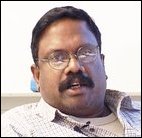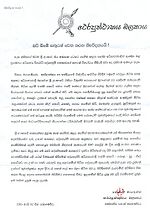Taraki Sivaram facts for kids
Quick facts for kids
Maamanithar
Taraki Sivaram
|
|
|---|---|

Dharmeratanam Sivaram
|
|
| Born |
Dharmeratnam Sivaram
11 August 1959 Batticaloa, Sri Lanka
|
| Died | 28 April 2005 (aged 45) Colombo, Sri Lanka
|
| Nationality | Sri Lankan |
| Occupation | Journalist, writer, author |
| Title | Mr. |
| Spouse(s) | Herly Yogaranjini Poopalapillai |
| Children | Vaishnavi, Vaitheki, and Andrew Seralaathan |
Taraki Sivaram or Dharmeratnam Sivaram (born August 11, 1959 – died April 28, 2005) was a well-known Tamil journalist from Sri Lanka. He was taken by four men on April 28, 2005. His body was found the next day, with signs of violence.
Contents
About Taraki Sivaram
Sivaram was a famous writer and editor for Tamilnet.com. He was born on August 11, 1959, in Batticaloa, Sri Lanka. His family was important in the area. He went to school at St. Michael's College National School and later at Pembroke and Aquinas College in Colombo. He started at the University of Peradeniya in 1982 but left because of the early parts of the Sri Lanka civil war in 1983.
On September 8, 1988, he married Herly Yogaranjini Poopalapillai. They had three children: Vaishnavi, Vaitheki, and Seralaathan.
Early Political Involvement
In 1982, Sivaram joined the Gandhian Movement. This group was connected to the People's Liberation Organisation of Tamil Eelam (PLOTE), which was one of many Tamil groups. When the civil war started in 1983, Sivaram became a member of PLOTE, using the name SR. In 1988, he became the General Secretary of the Democratic People's Liberation Front (DPLF), which was PLOTE's political party. Sivaram left PLOTE in 1989 because he disagreed with some of their plans.
His Journalism Career
In 1988, a fellow journalist named Richard De Zoysa encouraged Sivaram to become a reporter. Sivaram started working for the UN-funded Inter Press Service (IPS). In 1989, when The Island newspaper needed a political writer, De Zoysa suggested Sivaram. The editor wanted to call him tharaka, meaning star in Sinhalese. But a sub-editor accidentally printed Taraki instead, and that became Sivaram's famous pen name. In 1990, Sivaram helped identify Richard De Zoysa's body after De Zoysa was kidnapped and killed.
Why His Articles Were Popular
Taraki's articles were special because they mixed his personal writing style with accurate, inside information. He explained the military, political, and strategic parts of the conflict in Sri Lanka. He also studied military science and political philosophy, which helped his writing a lot.
By the early 1990s, many people who were interested in Sri Lanka had to read Sivaram's "Taraki" column. He wrote for many newspapers, including The Island, The Sunday Times, Tamil Times, The Daily Mirror, and the Tamil newspaper Virakesari. In 1997, Sivaram helped Tamilnet.com become a news agency with its own reporters. He was a senior editor there until he died. He sent his last story to Tamilnet.com on the night he was killed.
Working with Experts
Because Sivaram understood Tamil politics and Sri Lanka's history so well, he worked with many university experts. He collaborated with historians, political scientists, anthropologists, and other scholars from universities in Sri Lanka and around the world. His main partners were Professor Mark Whitaker and Dr. Jude Fernando.
Helping Human Rights Groups
In the mid-1990s, many governments and human rights groups asked Sivaram for advice on local political and military issues. He traveled widely in Europe, Asia, and North America. He was well-known to governments, diplomats, and human rights activists. He was killed just before he was supposed to go to Japan to talk with the Japanese government about the peace process at that time.
Threats to His Safety
When Sivaram started getting threats, his friends and colleagues asked him to leave Sri Lanka with his family. But he always refused to go.
He often said, Where else should I die but here? In 2004, the police searched Sivaram's home twice. Also, some political groups in Sri Lanka publicly threatened him.
Global Response to His Death

After his death, countries like Japan and international groups like Reporters Without Borders and UNESCO spoke out. They condemned his murder and asked the Sri Lankan government to investigate.
Investigation and Concerns
The Liberation Tigers of Tamil Eelam (LTTE) group said the government was involved in his murder. Before he died, government-owned news had called him an LTTE spy. One year later, a Tamil man from the PLOTE group was arrested. However, people who saw the kidnapping could not say he was one of the kidnappers. There has not been much more news about the government's investigation.
Reporters Without Borders, a group that supports press freedom, stated, "The Sri Lankan authorities have sadly shown they don't really want to solve cases where journalists are killed or attacked."
His Lasting Impact
After he died, Sivaram became a symbol for Tamil activists and journalists worldwide. He is remembered for his work, which focused on the struggles of the Eelam Tamils and helping oppressed people everywhere. His colleague, Dr. Jude Fernando, said:
He will be an irreplaceable loss to the academic and human rights community around the world
The poet Kaasi Ananthan called him a fair journalist who was not driven by strong feelings about race. After his death, he was given the title Maamanithar, which was the highest civilian honor in the former state of Tamil Eelam by LTTE Leader Velupillai Prabhakaran.
In 2015, people remembered the 10th anniversary of his death in different parts of Tamil Nadu and Sri Lanka. A documentary film about Taraki's work was also shown on World Press Freedom Day in Chennai.
See also
- Tamilnet
- Interview with Dharmaratnam Sivaram
Collection of Writings
- 1991 An Insider's analysis of the Ethnic Conflict in Sri Lanka
- Collection of his writings at Tamilnation.org

